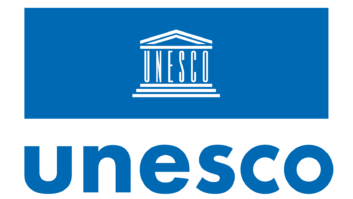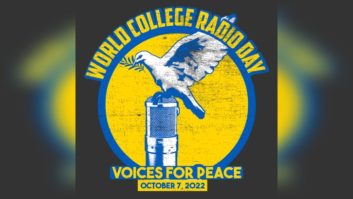Test your comprehension and memory of Radio World’s 2012 coverage of news, technology and regulation. Answers are at bottom.
1. What is “Artist Experience”?
a. A website in support of performance royalties
b. A channel on iHeartRadio
c. A way to embed visuals to accompany on-air audio
d. A lounge at the spring NAB Show
2. The legal fight over patents involving radio automation was brought by Mission Abstract Data. What associated company name have the plaintiffs used?
a. Fletcher Heald and Hildreth
b. Shapiro Smith and Genachowski Inc.
c. DigiMedia Holding Group LLC
d. Straight Wire Audio
3. Identify the man at left in the accompanying photo.
a. David Layer
b. David Pogue
c. Victor Tawil
d. Kevin Gage
e. George Clooney

4. Engineering innovator and AM stereo advocate Leonard Kahn died in June. Which of these products was associated with Kahn?
a. CBS Audimax
b. Symmetra-Peak
c. Gates Sta-Level
d. Henry Matchbox
5. What does the Smith-Mundt Act forbid, as generally interpreted?
a. Ownership of more than one radio or TV station in the same market as a newspaper owned by the same entity.
b. Ownership of more than 49% of a U.S. broadcast license by a foreign entity.
c. Domestic dissemination by the U.S. government’s international broadcasting organizations.
d. Claiming a minority ownership tax credit when an FM translator is used by an AM station.
6. What is AES-X192?
a. An AES standards task group for audio interoperability over high-performance IP networks
b. An AES standards task group for compatibility of metadata as commonly used in “infotainment” systems
c. An AES conference set for summer 2013 focusing on new consumer electronics technologies
d. The working name for a proposed revision to the AES3 standard for the transport of digital audio signals between pro audio devices.
7. What is the main benefit of MDCL?
a. Energy-saving transmitter control for AM stations
b. Higher efficiency in FM station transmitters
c. Management of multiple EAS receivers serving a single station cluster
d. Compatibility among devices connected to Internet protocol networks of differing standards
8. Which entity earned a Radio World “Cool Stuff” Award for its new method of high-level IBOC combining for single-input antenna systems?
a. Altronic Research
b. Belar Electronics Lab
c. Electronics Research Inc.- ERI
d. NPR Labs

9. Which organization had the U.S. radio rights to cover the London Olympics?
a. Triton Digital
b. CBS
c. Cumulus Media
d. Dial Global
10. This organization reviewed its FM translator applications to comply with a presumed national cap of 50. It withdrew about 200 applications but had 300 remaining from an earlier window.
a. Prometheus Radio Project
b. REC Networks
c. Womble Carlyle
d. Educational Media Foundation
11. In comments to the FCC, iBiquity Digital wrote the following; fill in the blank: “The comments demonstrate a broad industry consensus that the use of _________ will allow broadcasters to enhance their digital service and that the FCC should authorize this mode of operation.”
a. Artist Experience
b. Modulation-dependent carrier level
c. –10 dBc digital power
d. Asymmetric sidebands

12. “As a child, our summer vacations were actually going to visit radio stations. We grew up in North Carolina. So when we were going to Florida we would stop at every radio station along the way. My dad would just go in and start talking to whoever was there.” Who said it?
a. Caroline Beasley
b. Diane Warren
c. Tom King
d. Tom Silliman
13. What company this year announced it will start to make TV transmitters for the first time?
a. Continental
b. Nautel
c. Harris
d. Bext

14. Three museums — the Gray History of Wireless Museum, the National Voice of America Museum of Broadcasting, and the Media Heritage collection — share one facility here.
a. Bethany, Md.
b. Bethany, Ohio
c. Greenville, N.C.
d. New York, N.Y.
15. Thanks to updates to Part 101 …
a. Terrestrial broadcasters must now have EAS receivers in place that are compatible with the Common Alerting Protocol.
b. Terrestrial broadcasters now have greater access to microwave spectrum to use as the final RF links in their program distribution chains.
c. Satellite services XM and Sirius now provide 4% of their channels to minority-owned entities and community organizations.
d. LPFM stations need no longer protect full-power broadcasters on second-adjacent frequencies.

16. He was SBE Member 1.
a. John Battison
b. Steve Church
c. Jules Cohen
d. John Verboon
17. Who said, “It takes me five minutes to get some of the most technologically innovative people to say, ‘Radio is innovative again. You’ve married the open mic with a device that someone looks at 40 to 50 times a day.’”
a. Paul Brenner, Emmis
b. Bud Aiello, NPR
c. Gordon Smith, NAB
d. Milford Smith, Greater Media
18. Which two companies are exploring a concept called ZoneCasting?
a. Nautel and Orban
b. Wheatstone and Telos
c. NAB and CEA, via the NRSC
d. Geo-Broadcast Solutions and Harris
19. What is the goal of the Internet Radio Fairness Act?
a. To assure that no single business entity enjoys a monopoly position in the evolving U.S. Internet radio industry.
b. To adopt fair standards by which determinations of Copyright Royalty Judges are made with respect to webcasting.
c. To require Internet streaming webcasters to provide equal time to opposing points of view.
d. To encourage new entrants into Internet radio and streaming by providing a discount tax rate in the first three years of operation.
20. Which FCC commissioner called for a review of AM rules in a speech at the fall Radio Show?
a. Ajit Pai
b. James Quello
c. Mignon Clyburn
d. Julius Genachowski
ANSWER KEY
1. – c. A way to embed visuals to accompany on-air audio
2. – c. DigiMedia Holding Group LLC
3. – d. Kevin Gage
4. – b. Symmetra-Peak
5. – c. Domestic dissemination by the U.S. government’s international broadcasting organizations.
6. – a. An AES standards task group for audio interoperability over high-performance IP networks
7. – a. Energy-saving transmitter control for AM stations
8. – c. Electronics Research Inc.- ERI
9. – d. Dial Global
10. – d. Educational Media Foundation
11. – d. Asymmetric sidebands
12. – a. Caroline Beasley
13. – b. Nautel
14. – b. Bethany, Ohio
15. – b. Terrestrial broadcasters now have greater access to microwave spectrum to use as the final RF links in their program distribution chains.
16. – a. John Battison
17. – a. Paul Brenner, Emmis
18. – d. Geo-Broadcast Solutions and Harris
19. – b. To adopt fair standards by which determinations of Copyright Royalty Judges are made with respect to webcasting.
20. – a. Ajit Pai












